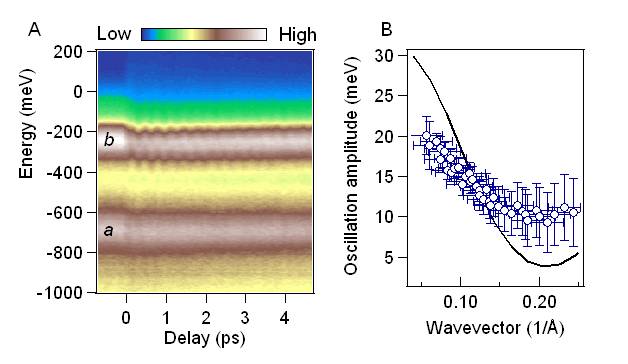Coherent phonons
Due to the distorted nature of atomic structure, the atomic positions of Bismuth are very sensitive to the electronic distribution in the conduction band. This conjecture has been experimentally verified by suddenly changing the occupation number of the electrons via the absorption of a femtosecond laser pulse. Due to photoexcitation, a large coherent phonon modulates the distance between the two atoms in the unit cell along the (111) direction. The displacement vector indicates that the lattice coordinates move towards a hypothetical phase with a single atom per unit cell. Such a dynamics can be directly observed on the photoelectron intensity map acquired as a function of pump probe delay. As shown in panel A, the position of the uppermost electronic band displays periodic modulations at the frequency of the coherently excited mode. We acquired similar intensity maps for different wavevectors along the G-M direction, finding large variation of the oscillation amplitude (see Panel B). This wavevector dependence of the electron-phonon coupling is essential for several problems of solid state physics: it accounts for the presence of charge density waves that do not respect the nesting condition and it allows for the correct estimate of the high transition temperature in superconducting MgB2.

[1] Coherent Phonon Coupling to Individual Bloch States in Photoexcited Bismuth; E. Papalazarou, J. Faure, J. Mauchain, M. Marsi, A. Taleb-Ibrahimi, I. Reshetnyak, A. van Roekeghem, I. Timrov, N. Vast, B. Arnaud, and L. Perfetti, Phys. Rev. Lett. 108, 256808 (2012).
[2] Direct observation of electron thermalization and electron-phonon coupling in photoexcited bismuth; J. Faure, J. Mauchain, E. Papalazarou, M. Marsi, D. Boschetto, I. Timrov, N. Vast, Y. Ohtsubo, B. Arnaud, and L. Perfetti, Phys. Rev. B 88, 075120 (2013).


